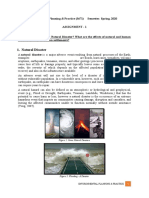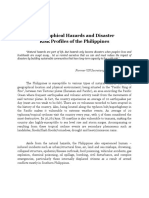The West Valley Fault
The West Valley Fault
Uploaded by
Jimuel AntonioCopyright:
Available Formats
The West Valley Fault
The West Valley Fault
Uploaded by
Jimuel AntonioOriginal Description:
Original Title
Copyright
Available Formats
Share this document
Did you find this document useful?
Is this content inappropriate?
Copyright:
Available Formats
The West Valley Fault
The West Valley Fault
Uploaded by
Jimuel AntonioCopyright:
Available Formats
THE WEST VALLEY FAULT
The West Valley Fault runs across the Metro Manila cities of Taguig, Muntinlupa,
Paranaque, Quezon City, Pasig, Makati, and Marikina as well as the surrounding
provinces of Rizal, Laguna, Cavite, and Bulacan. It is 100 kilometers long. When this
fault moves, these places will suffer a significant deal. And if it occurred, it may cause
an earthquake of a magnitude of 7.2, which would greatly devastate Metro Manila's
most developed area. This fault shifts every 200 to 400 years, according to DOST-
PHIVOLCS, and the last time it did so was in 1658, which was 359 years ago.
The threat is now extremely real, and every time a province along this fault's
length experiences severe ground tremors, people start to wonder when the big one will
strike out of fear for their lives and their possessions. Fear and apprehension are
growing, especially after recent tremors that rocked several areas of the nation. San
Marcelino, Pampanga, experienced a 5.4 magnitude earthquake on May 25, 2017.
Metro Manila, Cavite, Laguna, Rizal, Nueva Ecija, Pampanga, and Bataan were all
affected by this. Given these, it is necessary to tell the public about these incidents in
order for them to be better prepared and to experience less dread.
Although Metro Manila is thought to be the most developed region in the nation,
when a devastating earthquake strikes, it looks to be the most dangerous and
uninhabitable metropolis. Dr. Renato U. Solidum, Jr., DOST Undersecretary for Disaster
Risk Reduction and Climate Change Adaptation, stated during one of the plenary
presentations of the 17th Science Council of Asia Conference, which the National
Research Council of the Philippines hosted in 2017 at the Philippine International
Convention Center, that when the West Valley Fault moved and generated a 7.2
magnitude earthquake, 34,000 people may die and will damage lifelines including water,
infrastructure, and social services. The population concentration in Metro Manila as well
as the many non-engineered and earthquake-resistant structures and infrastructures
are the main contributing causes.
Additionally, there is a real possibility that the entire nation would experience a
period of economic paralysis due to the fact that the majority of government institutions
and commercial enterprises are located in overcrowded structures in Metro Manila.
These would entail a brief halt in operations because Metro Manila is where the majority
of the country's economic powerhouses are situated. Dr. Solidum participates actively in
the NRCP Division of Earth and Space Sciences, which is tasked with conducting
research on a variety of natural phenomena in order to provide some scientific
information clarifying the occurrences of these phenomena and their favorable or
unfavorable effects on people and the planet as a whole.
You might also like
- BFP-Oplan PaghalasaDocument7 pagesBFP-Oplan PaghalasaMaricar Mangaoang100% (1)
- Contingency PlanDocument112 pagesContingency PlanAira RonquilloNo ratings yet
- CLUB FOOT BASS (Ver 2) by Kasabian @Document2 pagesCLUB FOOT BASS (Ver 2) by Kasabian @Paulo MilfhunterNo ratings yet
- Trade and Exchange in The Medieval Islamic WorldDocument3 pagesTrade and Exchange in The Medieval Islamic WorldIna KadoNo ratings yet
- Articles About The Possible Event Scenario in The Event of The "Big One" EarthquakeDocument2 pagesArticles About The Possible Event Scenario in The Event of The "Big One" EarthquakeRonald Cambil Jr.No ratings yet
- West Valley FaultDocument12 pagesWest Valley FaultTwinkleAnneGonzalesRosalesNo ratings yet
- West Valley Fault: Its One of The Two Major Cracks of TDocument6 pagesWest Valley Fault: Its One of The Two Major Cracks of TSophia E. BucarileNo ratings yet
- What Dangers Await When The West Valley Fault MovesDocument15 pagesWhat Dangers Await When The West Valley Fault MovesKakal D'GreatNo ratings yet
- DRRR News ArticleDocument4 pagesDRRR News ArticleNovelyn AppillanesNo ratings yet
- Hon. Mayor Arlene B. Arcillas: September 25, 2020Document2 pagesHon. Mayor Arlene B. Arcillas: September 25, 2020Fauleen Angela MalaquillaNo ratings yet
- Porio 2011Document22 pagesPorio 2011Erika SemillanoNo ratings yet
- M7 Damaged To ManilaDocument2 pagesM7 Damaged To ManilaGelbert SilotNo ratings yet
- Disaster Added InfoDocument14 pagesDisaster Added InfosonnyNo ratings yet
- Disaster ManagementDocument15 pagesDisaster ManagementJohana Layto LucasNo ratings yet
- 45 04eDocument13 pages45 04eMaria Kathreena Andrea AdevaNo ratings yet
- 45 04e PDFDocument13 pages45 04e PDFIvy Grace BarteNo ratings yet
- Natural Disaster: Course: Environmental Planning & Practice (3671) Semester: Spring, 2020 Assignment - 1Document5 pagesNatural Disaster: Course: Environmental Planning & Practice (3671) Semester: Spring, 2020 Assignment - 1adeel raziNo ratings yet
- Flood Disaster Risk ReductioDocument18 pagesFlood Disaster Risk ReductioJeremiah Miko LepasanaNo ratings yet
- Tuesday, 11 April 2017 14:14: Primer On The April 2017 Series of Earthquakes in Batangas ProvinceDocument7 pagesTuesday, 11 April 2017 14:14: Primer On The April 2017 Series of Earthquakes in Batangas ProvinceJamaica RamosNo ratings yet
- 3rd Activity in Disaster Readiness and Risk Reduction 1Document3 pages3rd Activity in Disaster Readiness and Risk Reduction 1Laurence MatthewNo ratings yet
- Seismic Hazard Analysis For Public Infrastructure in Metro ManilaDocument4 pagesSeismic Hazard Analysis For Public Infrastructure in Metro ManilaJezzica BalmesNo ratings yet
- Disaster Readiness and Risk ReductionDocument11 pagesDisaster Readiness and Risk Reductionjhaitiman111No ratings yet
- Community-Based DRRM: Sto. Domingo, Quezon City, Philippines ExperienceDocument69 pagesCommunity-Based DRRM: Sto. Domingo, Quezon City, Philippines ExperienceJoyce SyNo ratings yet
- AJSS VulnerabilityandResiliencePaper PorioDocument22 pagesAJSS VulnerabilityandResiliencePaper PorioArtemio Jr A LonzagaNo ratings yet
- TP12 Lo PDFDocument10 pagesTP12 Lo PDFJefreyMatuanMondranoNo ratings yet
- 2050 Submersion - Floating CityDocument10 pages2050 Submersion - Floating CitymjmmarandaNo ratings yet
- Oct26.2013.dochouse Leader Asks MMDA, DPWH, DENR, LGUs To Come Up With Unified Flood Control Program For MMlaDocument1 pageOct26.2013.dochouse Leader Asks MMDA, DPWH, DENR, LGUs To Come Up With Unified Flood Control Program For MMlapribhor2No ratings yet
- Importance of Disaster ManagementDocument6 pagesImportance of Disaster Managementsikanderhayat007No ratings yet
- 2Document45 pages2roselletimagos30No ratings yet
- Envi Discussion Midterm1Document4 pagesEnvi Discussion Midterm1vanneza laurenteNo ratings yet
- RRL 1Document6 pagesRRL 1catlynagad02No ratings yet
- Effect of Flood On Businesses in SwatDocument8 pagesEffect of Flood On Businesses in SwatAliNo ratings yet
- Site Selection Process - Pamatmat, Skyler H. - 2023Document18 pagesSite Selection Process - Pamatmat, Skyler H. - 2023Kyle HipolitoNo ratings yet
- AAAAAAAAAAAAAADocument5 pagesAAAAAAAAAAAAAAChistine RiveraNo ratings yet
- Unit 1 Lesson 3Document7 pagesUnit 1 Lesson 3Kenzie ButtowskiNo ratings yet
- The Big OneDocument1 pageThe Big OneMicah SapadenNo ratings yet
- Reaction Paper GIODocument1 pageReaction Paper GIOYen Yen Nicolas100% (1)
- SssDocument8 pagesSssWagun Lobbangon BasungitNo ratings yet
- DRRR - Position PaperDocument1 pageDRRR - Position PaperRafael LabradorNo ratings yet
- 2.2 Flooding in PhilippinesDocument3 pages2.2 Flooding in PhilippinesainarifahNo ratings yet
- Introduction To Philippine Disaster 02Document71 pagesIntroduction To Philippine Disaster 02Kyra Lalaine Angub CervantesNo ratings yet
- Earthquake Impact Reduction Study For Metropolitan Republic of The PhilippinesDocument5 pagesEarthquake Impact Reduction Study For Metropolitan Republic of The PhilippinesCarlo IsananNo ratings yet
- Wanted - Hovercraft & Other Modern TransportationDocument13 pagesWanted - Hovercraft & Other Modern Transportationbloybloy100% (1)
- Typhoon UlyssesDocument3 pagesTyphoon UlyssesLaura FeNo ratings yet
- Risk Factors Underlying DisastersDocument30 pagesRisk Factors Underlying DisastersFranciene CandareNo ratings yet
- NSTP ActivityDocument1 pageNSTP ActivityKelsy Laye Khloe' RamirezNo ratings yet
- Group 5DRRRDocument3 pagesGroup 5DRRRkagameshizuyakuNo ratings yet
- Rising Population, Urbanization Compound Perils of Earthquakes Temblors Not Increasing, But Many More People Are in Harm's WayDocument2 pagesRising Population, Urbanization Compound Perils of Earthquakes Temblors Not Increasing, But Many More People Are in Harm's WayJenny ValderramaNo ratings yet
- UST NSTP e-READ Chapter4Document53 pagesUST NSTP e-READ Chapter4Jaimee NavarroNo ratings yet
- Natural and Anthropogenic Hazards in Metro Manila 2015-07Document33 pagesNatural and Anthropogenic Hazards in Metro Manila 2015-07aubreywhymark100% (1)
- Natural Disaster Position PaperDocument3 pagesNatural Disaster Position PaperArlene Joy Dacpano100% (1)
- 2nd ARC - Disaster Management (3rd Report) Gist of Chapter 1 To 3 MrunalDocument18 pages2nd ARC - Disaster Management (3rd Report) Gist of Chapter 1 To 3 MrunalSivaKumar100% (3)
- Can You Recall The Typhoons That Hit The Different Regions ofDocument15 pagesCan You Recall The Typhoons That Hit The Different Regions ofRaj MiraflorNo ratings yet
- Etech BlogDocument1 pageEtech BlogMary Criz TorionNo ratings yet
- E Salakan Mobile Based Disaster Management For Naguilian La Union ManuscriptDocument47 pagesE Salakan Mobile Based Disaster Management For Naguilian La Union ManuscriptJoshuaNo ratings yet
- Quiz#6 (NEWS ARTICLE) - Javier, Daniela, T.Document2 pagesQuiz#6 (NEWS ARTICLE) - Javier, Daniela, T.DaNica Tomboc JavierNo ratings yet
- A Tale of Two DecadesDocument4 pagesA Tale of Two DecadesAdonis GaoiranNo ratings yet
- INTRODocument3 pagesINTROAndrea Gale Dela CruzNo ratings yet
- EarthquakeDocument13 pagesEarthquakeTitsuya YurikoNo ratings yet
- The Destroyer: (A Typhoon Ulysses Nightmare)Document2 pagesThe Destroyer: (A Typhoon Ulysses Nightmare)James Clarenze VarronNo ratings yet
- 2009 Typhoon Ondoy Flood Disasters in Metro Manila: Teruko SATO and Tadashi NAKASUDocument12 pages2009 Typhoon Ondoy Flood Disasters in Metro Manila: Teruko SATO and Tadashi NAKASUAngel RondillaNo ratings yet
- The Future Earth: A Radical Vision for What's Possible in the Age of WarmingFrom EverandThe Future Earth: A Radical Vision for What's Possible in the Age of WarmingNo ratings yet
- The Importance of Documents in Our Daily LifeDocument2 pagesThe Importance of Documents in Our Daily LifeJimuel AntonioNo ratings yet
- Shopee Case StudyDocument2 pagesShopee Case StudyJimuel AntonioNo ratings yet
- Statement of The ProblemDocument1 pageStatement of The ProblemJimuel AntonioNo ratings yet
- What Are The Uses and Abuses of Statistics in The Real WorldDocument1 pageWhat Are The Uses and Abuses of Statistics in The Real WorldJimuel AntonioNo ratings yet
- Script For A 2 Minute VlogDocument3 pagesScript For A 2 Minute VlogJimuel AntonioNo ratings yet
- Women in Political AffairDocument6 pagesWomen in Political AffairJimuel AntonioNo ratings yet
- The Positive Impact of Internet On LearningDocument5 pagesThe Positive Impact of Internet On LearningJimuel AntonioNo ratings yet
- A Detailed Lesson Plan in English 10Document6 pagesA Detailed Lesson Plan in English 10Jimuel AntonioNo ratings yet
- Utilitarian PrincipleDocument1 pageUtilitarian PrincipleJimuel Antonio0% (1)
- 09 Performance Task 1Document2 pages09 Performance Task 1Jimuel AntonioNo ratings yet
- Swot AnalysisDocument1 pageSwot AnalysisJimuel AntonioNo ratings yet
- Common Coping Mechanisms of Senior High School StudentsDocument5 pagesCommon Coping Mechanisms of Senior High School StudentsJimuel AntonioNo ratings yet
- Unit I The Teacher and The School CurriculumDocument13 pagesUnit I The Teacher and The School CurriculumJimuel AntonioNo ratings yet
- CLHS403 Group9Document41 pagesCLHS403 Group9Jimuel AntonioNo ratings yet
- ThesisDocument1 pageThesisJimuel AntonioNo ratings yet
- Blessed Escueta - Death of A Salesman-Moral StoryDocument1 pageBlessed Escueta - Death of A Salesman-Moral StoryJimuel AntonioNo ratings yet
- Final PPT NG Mga Ferson!!!Document42 pagesFinal PPT NG Mga Ferson!!!Jimuel AntonioNo ratings yet
- GROUP 1 - Self Assessment of Pre-Service Teachers' PreparednessDocument30 pagesGROUP 1 - Self Assessment of Pre-Service Teachers' PreparednessJimuel AntonioNo ratings yet
- Unit V School Curriculum Changes, Reforms, and Innovations: Learning ObjectivesDocument14 pagesUnit V School Curriculum Changes, Reforms, and Innovations: Learning ObjectivesJimuel AntonioNo ratings yet
- Tech Note - FBB - E325727 - FleetOne - SW - Release - 127 Rev - BDocument4 pagesTech Note - FBB - E325727 - FleetOne - SW - Release - 127 Rev - BThuong Do chiNo ratings yet
- De Luna Jasie Jay A. Bsit 1a Module 2 AnswerDocument9 pagesDe Luna Jasie Jay A. Bsit 1a Module 2 AnswerJasie Jay De LunaNo ratings yet
- Department of Mechanical Engineering: Machine Design & CAD-II Lab (MEEN-3238)Document52 pagesDepartment of Mechanical Engineering: Machine Design & CAD-II Lab (MEEN-3238)Sarmad HafeezNo ratings yet
- Como Compilar DelftDocument24 pagesComo Compilar DelftReinaldo Barriga BNo ratings yet
- Reflection Paper FinalDocument3 pagesReflection Paper Finalapi-238534518100% (1)
- 4 SB RomperDocument3 pages4 SB RomperMaría Teresa Hernández Gamarra50% (6)
- Final Exam (Meto)Document7 pagesFinal Exam (Meto)ScribdTranslationsNo ratings yet
- Manual Nissan Murano 2015Document425 pagesManual Nissan Murano 2015Gabriel Ramirez SalasNo ratings yet
- West Coast JazzDocument5 pagesWest Coast JazzPetoleNo ratings yet
- Code of EthicsDocument1 pageCode of EthicsEdelman100% (4)
- Mae Tagarao Resume 2023Document1 pageMae Tagarao Resume 2023Mae TagaraoNo ratings yet
- Part I: Multiple Choice: Choose The Best Answer From The Given Alternatives and The Correct Letter On The Answer Sheet ProvidedDocument2 pagesPart I: Multiple Choice: Choose The Best Answer From The Given Alternatives and The Correct Letter On The Answer Sheet ProvidedGetahun FantahunNo ratings yet
- Copper Sulphate TitrationDocument29 pagesCopper Sulphate TitrationTeejay Makazhu100% (1)
- Single-Case Research Design and Analysis New Directions For Psychology and Education Thomas R. KratochwillDocument247 pagesSingle-Case Research Design and Analysis New Directions For Psychology and Education Thomas R. Kratochwilliting.sam100% (1)
- Karnataka Regional Diocesan Icym Dexco Team DetailsDocument8 pagesKarnataka Regional Diocesan Icym Dexco Team DetailsShivaNo ratings yet
- Rithanya Report FinalDocument32 pagesRithanya Report FinalthirusararrNo ratings yet
- Norman 20 - EnglishDocument30 pagesNorman 20 - EnglishLeonardo OliveiraNo ratings yet
- Alds WS English 9 Q2 W5 6Document12 pagesAlds WS English 9 Q2 W5 6pwdfhgmg26No ratings yet
- Communicating or Just Making Pretty Shapes Colin Wheildon 1990Document20 pagesCommunicating or Just Making Pretty Shapes Colin Wheildon 1990Ideas BcnNo ratings yet
- Firefly RPG - Smuggler's Guide To The Rim PDFDocument294 pagesFirefly RPG - Smuggler's Guide To The Rim PDFÓscar Soto Peris100% (7)
- Votem Catalog Final (L) PDFDocument12 pagesVotem Catalog Final (L) PDFCarlos José DiazNo ratings yet
- Polish Pass - The Witch Next DoorDocument6 pagesPolish Pass - The Witch Next Doorapi-565376620No ratings yet
- Lord Kuthumi - Dolphins SpeakDocument8 pagesLord Kuthumi - Dolphins SpeakEmeraldRay0% (1)
- Revision Guidance For Mce TrainingsDocument2 pagesRevision Guidance For Mce TrainingsMutaganda Ami fideleNo ratings yet
- Lesson Plan in Health IV JonaDocument8 pagesLesson Plan in Health IV JonaJenelyn Limen100% (1)
- 99ACRES RENT Sector 82A GurugramDocument7 pages99ACRES RENT Sector 82A GurugramArunoday DevganNo ratings yet
- Chin CD CoverDocument32 pagesChin CD CoverJared RedmondNo ratings yet
- Report BSNL PDFDocument26 pagesReport BSNL PDFRoshdhi FrameNo ratings yet












































































































